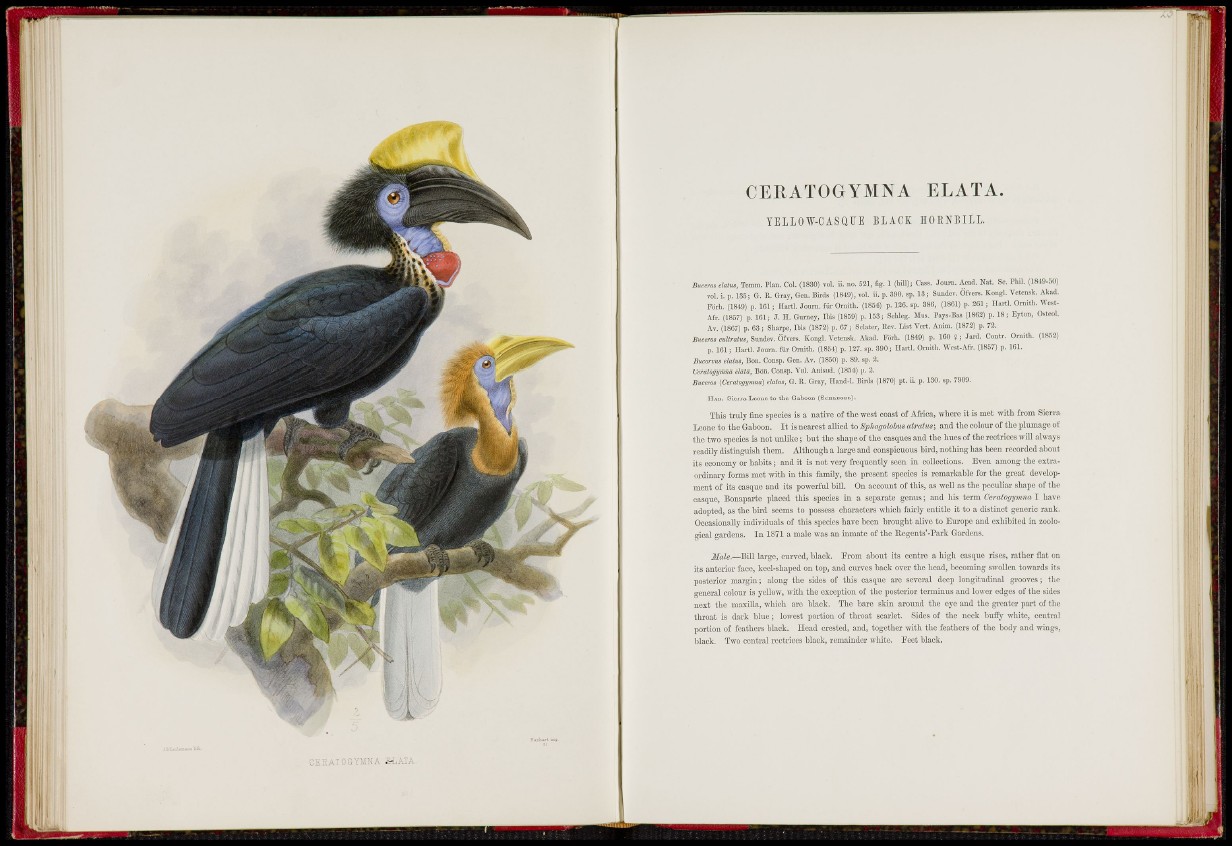
CERATOGYMNA ELATA.
Buceros eiatus, Temm. Plan. Col. (1830) vol. ii. no. 521, fig. 1 Cbill)j Cass. Joura. Acad. Nat, Sc. Phil. (1849-50)
vol. i. p. 135; G. R. Gray, Gen. Birds (1849), vol. ii. p. 390. sp. 13; Sundev. Ofvers. Kongl . Vetcnsk. Aknd.
Fork, (1849) p. 161 ; Ilartl. Joum. für Omi th. (1854) p. 126. sp. 38G, (1861) p. 261 , Haiti. Oniith. West-
Afr. (1857) p. 161; J. H. Gumey, IWs (1859) p. 153; Schleg. Mus. Pays-Bas (1862) p. 18; Eyton, Osteol.
Av. (1867) p. 6 3 ; Sharpe, Ibis (1872) p. 67; Sclater, Rev. List Vert. Anim. (1872) p. 72.
Sundev. Ofvers. Kongl. Vetensk. Akad. Forlì. (1849) p. 160 $; Janl. Contr. Omith. (1852)
p. 161; Ilartl. Joum. für Omi th. (1854) p. 127, sp, 390; Ilavtl. Ornith. West-Afr. (1857) p. 161.
Bucorvus eiatus, Bon. Consp. Gen. Av. (1850) p, 89. sp. 2.
Ceratogymna data, Bon. Consp. Vol. Anisod. (1854) p. 2,
Buceros {Ceratogymna) eiatus, G. R. Gray, Hand-1. Birds (1870) pt. Ü. p. 130. sp. 7909,
IIAB. Sierra Leone t o the Gaboon (SCHLEGEL) .
This truly fine specics is a native of the west coast of Africa, where it is met -with from Sierra
Leone to the Gahoon. It is nearest allied to Sphagolobus atratus-, and tlie colour of the plumage oi:
the two spccies is not unlike; but the shape of the casques and the hues of the rectrices-will always
readily distinguish them. Although a largo and conspicuous hird, nothing has heen recorded about
its cconomy or habits ; and it is not rery frequently seen in coHections. Even among the extraordinary
forms met with in this family, the present spccies is remarkable for the great development
of its casque and its powerful bill. On account of this, as well as the peculiar shape of the
casque, Bonaparte placed this species in a separate genus ; and Iiis term Ceratogymna I have
adopted, as the bird seems to possess characters which fairly entitle it to a distinct gencric rank.
Occasionally individuals of this species have been brought alive to Em-ope and exhibited in zoological
gardens. In 1871 a male was an inmate of the Regents'-Park Gardens.
Jfd^e.—Bül large, cm-vcd, black. Erom about its centre a high casque rises, rather flat on
its anterior face, keel-shaped on top, and em-ves back over the head, becoming swollen towards its
posterior margin ; along the sides of this casque are several deep longitudinal grooves ; the
general colour is yellow, with the exception of the posterior terminus and lower edges of the sides
nest the maxilla, which are black. The bare skin around the eye and the greater part of the
throat is dark blue ; lowest portion of throat scarlet. Sides of the neck buffy white, central
portion of feathers black. Ilcad crested, and, together with the feathers of the body and wings,
black. Two central rectrices black, remainder wMte. Pcet black.
C K B A T O G Y M N A .^.ALA,